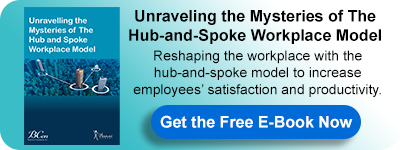The Hub-and-Spoke Model: A Sneak Peak
The office hub-and-spoke strategy is not a new concept; it has been employed in the real estate industry for many years. Simply put, a corporation will have a headquarters that serves as the business's hub, while the spokes are a geographically scattered network of offices that are usually focused on talent and client demands. The hub is usually located in a central location (city center) with good public transportation and serves as the company's cultural center. 1
This structure is a crucial driver of workspace mobility, as it combines a centralized main office (hub) with more localized satellite offices (spokes). The concept, which includes the house as a crucial spoke, boosts the alternatives and flexibility for employees by offering an attractive yet accessible combination of both home and office work.2
A company's central "hub" office serves as a site for meetings, team collaboration, and events in the hub-and-spoke office concept. It is usually found in a major city or the city's heart.
Satellite offices in smaller cities or communities closer to employees' homes are known as "spokes." On the other hand, a "spoke" does not always imply a traditional office. In a coworking space, flexible serviced office space, or even a home office, it can be a dedicated desk or many "hot desks." 3
The Quest for Employee's Comfort at Work
The COVID-19 pandemic has emphasized how firms can more effectively use schedules, space, and technology to be more productive, as it has upended the traditional concept of a company headquarters where employees congregate daily. Because more jobs may be completed and monitored online than ever before, copresence is no longer required for productivity.
Covid-19 also indicated how much firms and their employees desire freedom of choice. Hence, the pandemic has changed our working life' traditions in terms of "how" we work and "where" we work. 4
Yet, with the great resignation post the pandemic era, the war for talent has reached enormous heights, as employers are riding the wave in their attempts to hang on to their remaining talents. Therefore, employers need to appeal to the new normal and the changes in employees' needs and wants.
It's past time for businesses to rethink their approach to flexibility. Whether it's work-life balance, physical and emotional wellness, or family care, today's employees need flexibility suited to their unique needs. As they collaborate with HR to build unique, innovative solutions for their direct reports, managers will play a crucial role in personalizing flexibility for their direct reporters.
The alternative is to lose people and miss out on necessary talents. The most common reason people return to work after taking a break was workplace flexibility (44 percent). The need for flexibility is obvious, and leaders should think about these three aspects of flexibility if they genuinely wish to meet their employees' needs:
Where to Work: This is the most ingrained aspect of how businesses regard flexibility. Having control over where work can be done was crucial for nine out of ten individuals who left the job and eventually returned, regardless of whether the role was in person, remote, or hybrid. As a result, executives should think about providing people true control over where they work. Hybrid work arrangements with set office days are deceptively flexible, as not all aspects of in-person employment must be completed in person. One prominent tech company, for example, implemented a "Retail Flex" model that allows in-store personnel to handle tech support and online sales while working remotely.
When to work: Employees may be able to establish their own working days and hours, receive adequate notice of overtime and schedule changes so that work stays predictable, and take time off as needed. Controlling when they work was crucial in three out of four employees' decisions to take their present employment, whether they worked in person, hybrid, or remotely. Organizations must also find ways to reset employee expectations of 24/7 availability and avoid enforcing inflexible hours on staff to keep them. Organizations must have faith that the task will be completed and that employees will have enough time and energy to attend to their personal obligations and well-being. Email blackout periods were established by one large automotive business, with employees' capacity to send and receive work emails being disabled on weekends and corporate holidays.
How to Work: This third element of flexibility entails giving employees control over their everyday work activities, from allowing them to pace their workload to empowering them to choose how to complete tasks. Controlling how work is accomplished was a key motivation for three out of five in-person employees and four out of five hybrid or remote employees to take their current employment. Employees at one technology, media, and telecom corporation are rewarded for increasing efficiency. An example is of a savvy employee who managed to automate a time-consuming task and saved four hours per week. The company encouraged them to spend the "extra" time taking an extended lunch, working on a personally meaningful project, or fostering deeper connections with coworkers, rather than simply expanding their work responsibilities to fill the "extra" four hours.5
1Workthere, 9 Jan 2020, What is the hub and spoke model and how does it benefit the flexible office sector?, Accessed 19 Apr 2022, https://www.workthere.com/en-gb/news-guides/locations/what-is-the-hub-and-spoke-model-and-how-does-it-benefit-the-flexible-office-sector/
2MIT Sloan Management Review, 24 May 2021, Ben Laker, Why Companies Should Adopt a Hub-and-Spoke Work Model Post-Pandemic?, Accessed 19 Apr 2022, https://sloanreview.mit.edu/article/why-companies-should-adopt-a-hub-and-spoke-work-model-post-pandemic/
3Accessed, 19 Apr 2022, https://www.sharespace.work/blog/en/expert-article-en/hub-and-spoke-4-reasons-why-it-is-a-business-model-you-should-think-about/
4Management, 29 Sep 2021, Jackline Mukami, Why Companies Should Adopt a Hub-and-Spoke Work Model?, Accessed 20 Apr 2022, https://management-africa.co.ke/2021/09/29/why-companies-should-adopt-a-hub-and-spoke-work-model/
5Mckinsey, 14 Mar 2022, Lucia Darino, Umar Husain, Phil Kirschner and Rob Palter, Designing the workplace of tomorrow: lessons from life sciences, Accessed 21 Apr 2022, https://www.mckinsey.com/business-functions/people-and-organizational-performance/our-insights/the-organization-blog/designing-the-workplace-of-tomorrow-lessons-from-life-sciences
For more about this topic, download our latest book " Unraveling the Mysteries of The Hub and Spoke Workplace Model " for FREE:
